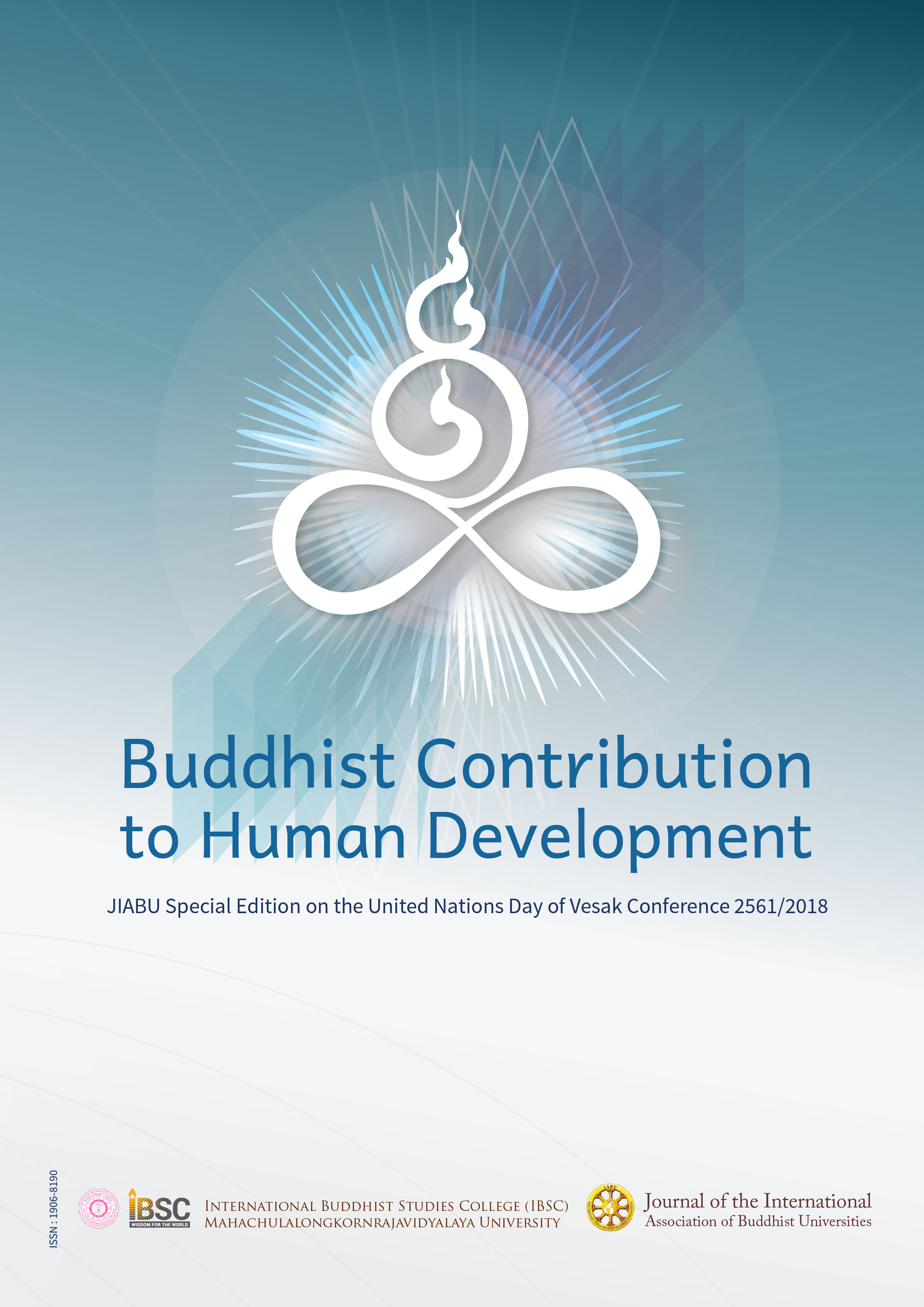The educational need to preserve Buddhist cultural identity in an inter-connected world
Main Article Content
Abstract
Mindful preservation of age-old Buddhist cultural manifestations is an ethical duty,
especially so in our present era when rapid cultural displacement and disruption have become
the norm under the ongoing onslaught of capitalism and consumerist modes of practice. The
unmindful sabotaging and annihilation of indigenous cultural patterns have become widely
prevalent. To counter this detrimental trend it is essential to go back to the roots of different
Buddhist cultural manifestations and preserve them in the original form for the ethico-religious
educational training of the younger generation. Buddhist cultural identity is a very broad
term and under its rubric, we will discuss a distinct tradition from Northeast Thailand (Isan),
which clearly depicts the adaptation and assimilation of a Buddhist Jataka story with local
modes of expression and ideas. While adaptation and assimilation give rise to the harmonious
blending of differences, preservation of distinctiveness leads to a tolerant acceptance of the
proliferation of the differences within and outside of one’s own community or region. These
are like two different flows of currents, but each can actually complement the other and in
this regard helps actualize the reinforcement of the threefold training of sīla, samādhi, and
paññā through cultural preservation. If we take the case of Northeast Thailand, we can see
the richness of the Buddhist cultural heritage of the region still being reflected through the
very unique twelve-month tradition, collectively named as Prapheni Heet Sibsong, and of
which the Mahachat Sung-sermon forms a major performative ceremonial event. But like
the rest of the country, Isan too is rapidly changing due to various factors operative in the
modernization process and we can witness a persistent eroding of ethico-cultural values
and doxastic foundation among the younger generation. If the process of cultural erosion
continues unabated, the younger generation would become completely ‘illiterate’ and hence
indifferent to the richness of the indigenous Buddhist culture that was once shaped by their
ancestors. Hence the need arises to give rise to samma vayama in preservation of the pristine
culture vis-à-vis the cosmopolitan forces that go against such preservation. The religion of
urbanization is not Buddhism, but materialism, and to sustain this new weltanschauung,
Buddhism gets either appropriated for material/worldly gains, or relegated and replaced
by a more secular and non-religious identity and mind-set for sheer ideological purpose,
both equally detrimental for Buddhists in the long run. Hence there is an exigent need
for an alternative interventionist stance to dismantle the two polarized positions – one of
appropriation for worldly consumerist gains, and the other of complete annihilation under
the guise of the ideology of secularism. Accepting the truth of the ethical role of such a
stance, this paper highlights the significance of preservation of Buddhist cultural identity
in an inter-connected world from within the context of Northeast Thailand.
Article Details
Views and opinions expressed in the articles published by The Journal of the International Association of Buddhist Universities (JIABU), are of responsibility by such authors but not the editors and do not necessarily reflect those of the editors.
References
Society, 1995.
De Silva, Lily. The Self-Made Private Prison. Kandy: Buddhist Publication Society,
1990.
Horner, I.B. The Book of Discipline. London: Pali Text Society, 1986.
Kawpaikabboon. Special Issue Jan–Mar, Khonkaen: Mahachulalongkornrājavidyālaya
University, 2009.
Khemachari, Phra Ariyanuwat. Rabiyab Boran Prapheni Thamboon Mahachat Phak Isan.
Publication details unknown, BE 2506.
Kornfi eld, Jack and Breiter, Paul, editors. A Still Forest Pool – The Insight Meditation of
Achaan Chah. Illinois: Theosophical, 1985.
Levinas, Emmanuel. Totality and Infi nity: An Essay on Exteriority. Translated by Alphonso
Lingis. Pittsburgh, PA: Duquesne University Press, 1969.
Mahanta (Visuddhangkoon), Dipti. A Critical Study of the Mahachat Sung-sermon from
Isan. Research Monograph, Bangkok: Buddhist Research Institute, 2009.
. “Boonkumkhaoyai: An exemplary model of Buddhist Economy.” In UNDV
Conference Proceedings. Bangkok: Dion Peoples, 2009.
Nimanhemin, Prakhong. Mahachat Lanna: Kansueksa Nai Thana Thi Pen Wannakhadi
Thongthin. Bangkok: Thai Wattana Phanich, BE 2526.
Payutto, P.A. Buddhadhamma, Albany: State University of New York Press, 1995.
. Buddhist Economics, Bangkok: The National Identity Board, 1994.
. Dictionary of Buddhism, Bangkok: Mahachulalongkornrajavidyalaya University
Press, 2000.
Phinthong, Preech. Saranukrom Phasa Isan-Thai-Angkrit. Ubonrachathani: Rongphim
Siritham, BE 2532.
Phithipong, Phinthip. “Wannakam Laeh Jak Amphur Phanthong Changwat Chonburi”,
dissertation in Thai, (Srinakharinth University), BE 2524.
Punnothok,Thawat. Wannakam Thongthin. Bangkok: Phirawatana, BE 2525.
Reungsuwan, Jarubut. Khong Dee Isan. Bangkok: Kansasana, BE 2520.
Samyutta Nikāya: The Grouped Discourses. London: Pali Text Society.
Sutasarapimol, Phrakhru. Phimpha Laeh Mahāchat 13 Kanth Isan version พิมพา แหล่มหาชาติ
๑๓ กัณฑ์ สำนวนอีสาน. Khonkaen: Klangnanatham, BE 2549.
Thammawat, Jaruwan. Laksana Wannakam Isan (Characteristics of Isan Literature),
Mahasarakham: Srinakharinvirot University, BE 2521.
Viravong, Sila. Baeb Taeng Klong Thai Vienjan (Composition of Thai-Vientianne poetry).
Publication details unknown, BE 2485.
. Santhalaksana Waiyakorn Lao Phak Si (Manual of Versification, Lao Grammar,
Part Four). Vientianne: Ministry of Education, 1970.
Visuddhangkoon, Dipti “The Isan Mahachat Sung-sermon (Thet Laeh): Some reflections on
its Narratological aspects.” In Transcript, Vol. III, edited by Zothanchhingi Khiangte,
29-43. Visakhapatnam: Global Publishing House, 2015.
. “Prapheni Heet Sibsong: The Tradition of Merit Making with Ethical Commitment
to the ‘Other,’” In Gift and Duty, edited by Paul H. De Neui, Oregon: Resource
Publications, 2017.
Walpole, Rahula. What the Buddha Taught, Bangkok: Haw Trai Foundation, 1990.

